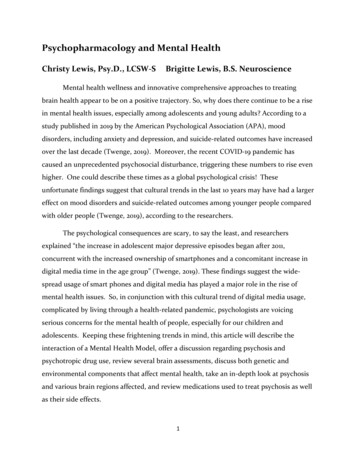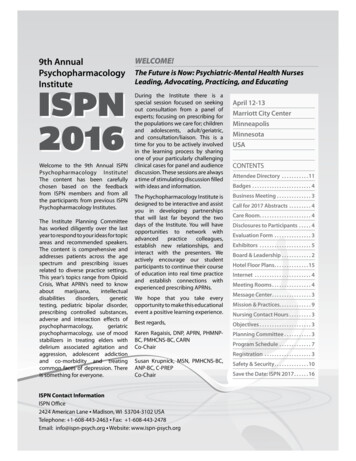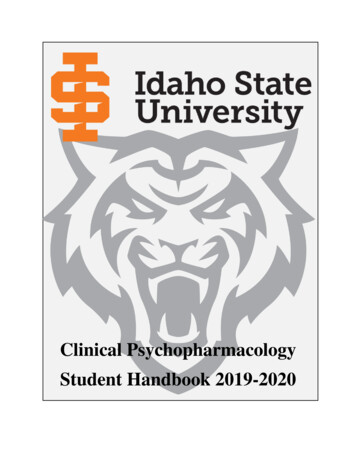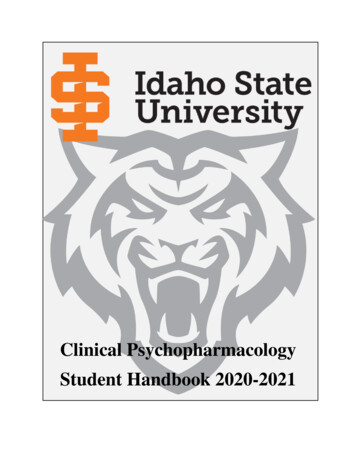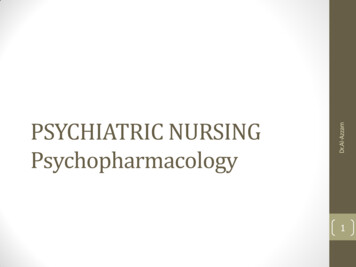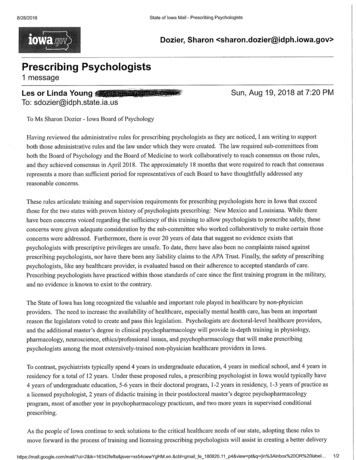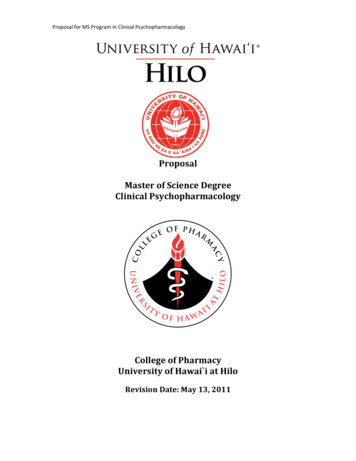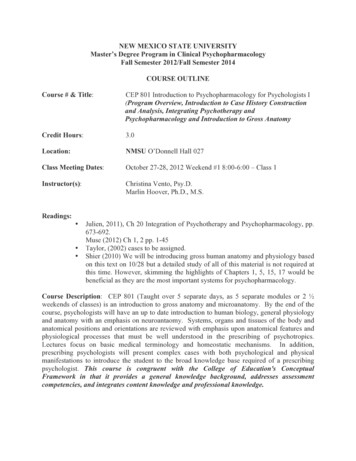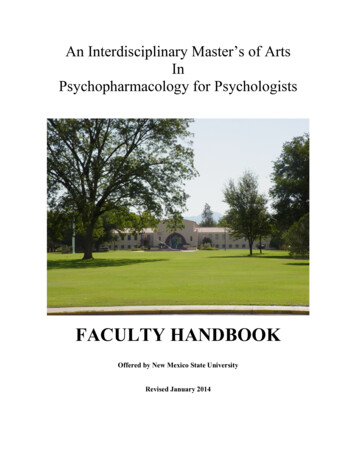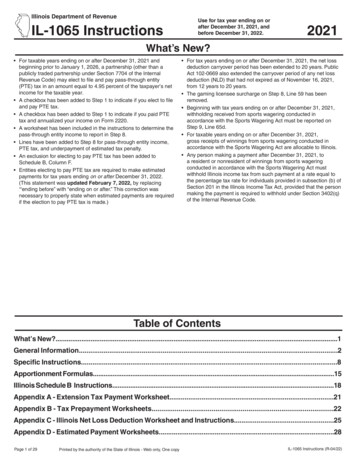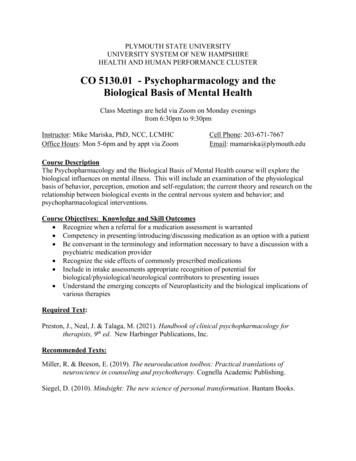
Transcription
PLYMOUTH STATE UNIVERSITYUNIVERSITY SYSTEM OF NEW HAMPSHIREHEALTH AND HUMAN PERFORMANCE CLUSTERCO 5130.01 - Psychopharmacology and theBiological Basis of Mental HealthClass Meetings are held via Zoom on Monday eveningsfrom 6:30pm to 9:30pmInstructor: Mike Mariska, PhD, NCC, LCMHCOffice Hours: Mon 5-6pm and by appt via ZoomCell Phone: 203-671-7667Email: mamariska@plymouth.eduCourse DescriptionThe Psychopharmacology and the Biological Basis of Mental Health course will explore thebiological influences on mental illness. This will include an examination of the physiologicalbasis of behavior, perception, emotion and self-regulation; the current theory and research on therelationship between biological events in the central nervous system and behavior; andpsychopharmacological interventions.Course Objectives: Knowledge and Skill Outcomes Recognize when a referral for a medication assessment is warranted Competency in presenting/introducing/discussing medication as an option with a patient Be conversant in the terminology and information necessary to have a discussion with apsychiatric medication provider Recognize the side effects of commonly prescribed medications Include in intake assessments appropriate recognition of potential forbiological/physiological/neurological contributors to presenting issues Understand the emerging concepts of Neuroplasticity and the biological implications ofvarious therapiesRequired Text:Preston, J., Neal, J. & Talaga, M. (2021). Handbook of clinical psychopharmacology fortherapists, 9th ed. New Harbinger Publications, Inc.Recommended Texts:Miller, R. & Beeson, E. (2019). The neuroeducation toolbox: Practical translations ofneuroscience in counseling and psychotherapy. Cognella Academic Publishing.Siegel, D. (2010). Mindsight: The new science of personal transformation. Bantam Books.
PLYMOUTH STATE UNIVERSITY POLICIESAcademic IntegrityAcademic integrity is the foundation of the pursuit of knowledge. All members of the academiccommunity are expected to be dedicated to the pursuit of knowledge in an honest, responsible,respectful, and ethical manner. Every violation of academic integrity is an affront to theacademic community. Violations of academic integrity make fair evaluation impossible and castdoubt upon the seriousness with which students accept the responsibility of acquiring aneducation. Members of the academic community are expected to report all instances of thoseviolations that come to their attention. Both faculty and administration consider it their duty, asguardians of academic standards and intellectual honesty, to enforce the policy by prosecuting allcases of violations of academic integrity to the fullest extent. Students are urged to consider thatit is the toleration of violations of academic integrity, and not the reporting of it, that isdishonorable. Visit cies-procedures/graduateacademic-policies/ for more information on University policies and procedures regardingacademic integrity. In addition, please review APA guidelines on what constitutes plagiarism.Academic Integrity y-policies-procedures/Policy is listed under the “Academic Integrity” tab.ADA StatementPlymouth State University is committed to providing students with documented disabilities equalaccess to all university programs and facilities. If you think you have a disability requiringaccommodations, you should contact Campus Accessibility Services rvices/, (603-535-3300) to determine whether youare eligible for such accommodations. Academic accommodations will only be considered forstudents who have registered with CAS. If you have authorized CAS to electronically deliver aLetter of Accommodations for this course, please communicate with your instructor to reviewyour accommodations.Inclement WeatherSign up for PSU alerts for notification of weather-related cancellations and provide yourinstructor with a phone number that is the most reliable way of contacting you in the event hecancels class on a night when PSU remains open. Class members regularly commute from a widearea of the state where weather conditions may vary significantly from those in Plymouth.Travelling in inclement weather is always at your discretion. It is your responsibility to initiatemaking up missed material if you miss a class due to weather.Sensitive MaterialMaterial in this course, in some instances, may be sensitive or emotionally provocative. As youreview the syllabus, or at any time during the course, please let the instructor know if youanticipate, or are having, a problem with any assignment or classroom activity. It can then bediscussed how this assignment or activity is necessary for meeting course competencies andwhether an alternative assignment or activity can be considered. Campus resources that may behelpful in dealing with your concerns can also be discussed.
Counselor Education and School Psychology PoliciesPlymouth State University’s Counselor Education and School Psychology (CESP) Programs arecharged with the task of preparing individuals to become professional counselors or schoolpsychologists in a variety of settings and to assume positions of leadership in the field. In orderto fulfill these responsibilities, faculty will evaluate students based on their academic,professional, and personal qualities. The PSU CESP programs attempt to establish a learningcommunity where students can develop professionally. This is done by providing anenvironment in which students’ rights and responsibilities are respected, and by respecting thedignity and worth of each student.Student Monitoring: A student’s progress in the program may be interrupted for failure tocomply with academic standards or if a student’s interpersonal or emotional status interferes witheducation/training and client care related to requirements for self and others. For example, inorder to ensure proper training and client care, counselors/school psychologists-in-training mustabide by relevant ethical codes and demonstrate professional knowledge, technical andinterpersonal skills, professional attitudes, and professional character. These factors areevaluated based on academic performance and the ability to convey warmth, genuineness,respect, and empathy in interactions with clients, classmates, staff, and faculty. Students shouldbe able to demonstrate the ability to accept and integrate feedback, be aware of their impact onothers, accept personal responsibility, be able to express feelings appropriately, and evidenceprofessional judgment in decision making relative to issues and situations encountered in theprogram. See the student handbook for both the long and short versions of the student monitoringform.Student Responsibilities in Monitoring Peer Professional Competency: As a CESP student,it is important to learn how to support your fellow classmates and future colleagues. Professionalcodes of ethics highlight the importance of protecting the profession and those it serves byrecognizing unethical behavior, consulting with colleagues, and reporting to institutionalhierarchies if necessary. If you are concerned about a classmate’s ethical conduct, counselingcompetency, or psychological stability, you are encouraged to follow the policy in yourprogram’s student handbook to guide you in ethically dealing with these situations.Communications: Prompt and professional communication between students and professors isimportant and valued in the CESP programs. To that end, it is your responsibility to regularlycheck your PSU email account. As stated in the student handbooks, all universitycommunications will be to that address. We aspire to be a community that responds to each otherin a prompt and respectful way. To that end, we ask that you respond to professor or departmentemails within two business days. Likewise, faculty will aspire to respond to your emails withintwo business days. Note, we understand that there are circumstances in which students andfaculty may be unable to respond in a timely manner. During these periods, we will informothers when we will be available to respond.
Computers and Cell Phones Use in the Classroom: Computers and cell phones may bebrought into the classroom (obviously, since we will be attending class via Zoom) but their useshould be appropriate. Computers should be limited to academic class-related uses. Please keepyour microphone on mute unless you are speaking. Also, please turn your camera on duringclass, as it can be difficult to engage with a class where half the students don’t seem to beactually “there.” During guest speaker presentations, videos, student presentations, and any inclass role play activities please make sure you’re focused on the person speaking to be respectfulof your classmates. Finally, cell phones play an important role in emergency situations, but theyshould be kept on vibrate or silent mode and text messaging should be kept to a minimum.Late Assignments: Consistent with graduate level expectations, all assignments are expected ontheir due dates. However, exceptions to this rule may be made due to circumstances beyond thecontrol of students such as family emergencies, illness, injury, power outages, computermalfunctions, accidents and other situations. Because of these possibilities, students are stronglyadvised to complete their assignments in advance of the due date. Also, students should back uptheir work so that computer crashes will not delay assignments. Unless impossible, all requestsfor extensions for assignments must be made before the assignment is due. If an extension isgranted, the assignment should be submitted no later than one week from the due date. In caseswhere the reason for the delay may require a longer time period to complete, the decision toallow a longer extension will be made on a case-by-case basis. Students may be asked to providedocumentation to verify their request for an extension.If an assignment is handed in past the due date, the final grade for that assignment will have10% of the grade deducted for each day it is late.Canvas Assistance: For assistance navigating Canvas, visit the online knowledge base leDet?ID 809&SIDs 2518, or contact theHelp Desk at (603) 535-2929, or get in-person help at the Help Desk in Lamson Library.Fair Grading Policy: cies-procedures/Policy is listed under the “Fair Grading” tab.Papers: The Research Paper must be in APA format following the 2019 guidelines. TheNeuroscience Research Article Review does not need to be in APA formatting, but should utilizeproper citations and references. All papers must be submitted electronically via Canvas in aWord, PDF, Pages, or Open/LibreOffice format.Assignment File Names: Please title the file name for submitted writing assignments andrecordings with your last name first, then the name of the assignment. Here’s an example usingmy own last name: Mariska Research Paper.docx
STUDENT EVALUATION:Attendance and ParticipationResearch PaperNeuro Research Article ReviewNeuroeducation PresentationFinal ExamTotal20 points30 points15 points15 points20 points----------100 pointsASSIGNMENTS:Neuroscience Research Article ReviewFor this assignment, you are to find a recent (within the last 2-4 years) article in a journal orreputable scientific periodical that review new findings, innovations, or a better understanding ofthe brain and mental health.This article should focus on research related to our understanding of the brain and how itfunctions related to mental health and well-being. Choose an article that you find interesting,and that ultimately relates to your own future work with clients.Once you’ve selected an article, you must do the following:Part 1 – Post a new topic in the "Discussions" section located on the left hand side of the courseCanvas site. In this topic, post either an uploaded copy of your article, or a link to the locationwhere it can be read online. In addition, post the following, providing a paragraph or so for eachpart: A brief synopsis of the article’s findings. Its significance for your own future work with clients. Why did this interest you? (Primary focus) - How you would describe the key points, or new approach to a client,using language that is simple, approachable, and free of “jargon” or complex scientificterms. In other words, how would you put this information into “layman’s terms” so thatthe clients you’ll be working with can understand and use it?Part 2 – You are to choose and review two of the postings made by your classmates andcomment on them. Comments can include reflections on the subject of the article, its place inyour own future work with clients, questions you have that are left unanswered, and suggestionsand/or feedback on your classmate’s “layman’s terms” description. Essentially, I want you toshow me that you read their article and their topic on it well enough to respond to it.
Neuroeducation PresentationsThis assignment will give you some practice in working to understand a neuroscientific conceptand explaining it in simple terms to the people we’re helping.First, choose a specific issue (a problem or symptom of a psychological disorder) you anticipatediscussing with future clients, students, or parents. You need to focus on something specific(like hypervigilance symptoms in PTSD) rather than something broader (like PTSD itself).You’ll then want to dig up what research or information you can on this specific issue, and mostimportantly, our best understanding of what’s going on in the brain to cause it. This informationcan be drawn from readings, articles, and even non-scientific sources like self-help articles,children’s books, and Youtube videos. Just make sure to check for accuracy!Sign-ups for the date of your presentation will be done on the second day of class using an onlineform. This presentation should be about 5 minutes in length, and should ideally be done in aninformal style which would match a normal conversation with a client, student, or parent.Powerpoints, pictures, and/or other multimedia resources may be used, but please ensure youstick to the 5 minute time limit.The presentation should cover: The specific issue you’ve chosen, and the population you’ve created this explanation for. In simple, “layman’s terms,” describe to us what is happening or what has happenedneurologically with regard to this issue as best you can. You do not need to cover howthe issue needs to be addressed, unless that is part of the description of what’s happening.The “what and why” is the most important part of this explanation. (Optional but encouraged, especially for children!) A short and simple metaphor that canbe used to conceptualize what’s happening.Final ExamThe Final Exam will be given on the final course date and will cover all material reviewed in theclass and readings. This exam will be given in an electronic format using the Canvas platform.The exam will consist of Multiple Choice, True/False, Matching, and Short Essay questions.A study guide will be given out before the final exam.
Research PaperThis paper involves first examining the neurological and pharmacological aspects of a mentalhealth issue in greater depth, then translating this knowledge into useful and approachablelanguage for the population you plan to work with.To begin, choose a mental health issue that interests you, or one that you know you willencounter in your future career. It does not necessarily need to be one we’ve covered in class,though you will likely find those a bit easier to write about.Once you have a focus, address the following questions to construct your paper: Using modern research (ideally within the last 10-20 years or so) give your best overviewof what seems to be occurring neurologically for this mental health issue. What brainsystems are involved? What’s our best understanding of the problem? Are there areasthat we still do not understand? How has our understanding changed over the past fewdecades? Give an overview of medication options for this issue, then choose one specificmedication to explore in greater depth. Discuss our best understanding of how thismedication works, how it can help with the symptoms of this disorder, and any key sideeffects that can prove to be problematic. How well does this medication seem to work?Is the benefit worth the potential side-effects? How does a client typically take thismedication? (i.e. – how often, how long, etc.?) Imagine you have a client who is experiencing this mental health issue. Review how youwould describe what is occurring to them neurologically. How might you discussmedication options to utilize in addition to counseling or psychotherapy? Please keep inmind your client’s developmental / educational level, and what is appropriate to discussgiven our scope of practice as counselors. A vignette, or “I said / they said” back andforth is not only allowed, but encouraged for this part. I’d love to see just how you’dexplain things to a future client!This paper should utilize APA formatting with proper citations, and should be between 8-10pages in length (not counting the title page or references). You must utilize at least 6 references(can include the textbook if you’d like to use it)) in writing this paper. If they are relevant to theissue you’ve chosen, you may re-use resources from the Article Review and NeuroeducationPresentation. Web resources may also be utilized, but please ensure the resources you use comefrom professional, reputable, and accurate sources.COURSE GRADING SCALE:A96 – 100 %B83 – 86 %C73 – 76 %A- 90 – 95 %B-80 – 82 %C-70 – 72 %B 87 – 89 %C 77 – 79 %F00 – 70 %
COURSE CALANDERDATETOPICSREADINGS / ASSIGNMENTSClass 1Course Intro and Syllabus ReviewSyllabus5/10/21History of PsychopharmacologyTextbook Ch. 1 & 2Using an Integrated Approachto Mental HealthClass 2Intro to Neurobiology5/17/21Brain Structure & FunctionClass 3Neuroplasticity & Change5/24/21Memory, Conflict, & EpigeneticsClass 4Intro to Pharmacology5/31/21Compliance, Discontinuation,& “Red Flags”Class 5Depressive Disorders & Medication6/7/21Class 6Textbook Ch. 3and Assigned ReadingsAssigned ReadingsTextbook Ch. 4, 5, 23, & 24and Assigned ReadingsTextbook Ch. 7 & 17and Assigned ReadingsNeuroeducation PresentationsBipolar Disorder & Medication6/14/21Textbook Ch. 8 & 18and Assigned ReadingsNeuroeducation PresentationsClass 7Anxiety Disorders & Medication6/21/21Obsessive-Compulsive DisorderTextbook Ch. 9, 10, 19and Assigned ReadingsNeuroeducation Presentations
Class 8Psychotic Disorders & Medication6/28/21Neuroeducation PresentationsClass 9Asynchronous Class7/5/214th of July WeekendClass 10Trauma and the Brain7/12/21Post-Traumatic Stress DisorderClass 11Recreational Drug Use7/19/21Substance Abuse & WithdrawalOver-the-Counter SupplementsClass 127/26/21Textbook Ch. 11 & 20and Assigned ReadingsArticle ReviewPart 1 Due at midnight on 7/5Part 2 Due at midnight on 7/11Textbook Ch. 12and Assigned ReadingsNeuroeducation PresentationsTextbook Ch. 14, 21, & 22and Assigned ReadingsNeuroeducation PresentationsChild & AdolescentPsychopharmacologyTextbook Ch. 25and Assigned ReadingsDiversity ConsiderationsResearch Paper DueNeuroeducation PresentationsClass 13Borderline Personality Disorder8/2/21Sleep DisordersOther Miscellaneous DisordersTextbook Ch. 15, 16and Assigned ReadingsFinal Exam Opens 9pmNeuroeducation PresentationsClass 14Final ExamFinal Exam Due by 6pm!8/9/21Class Wrap-UpNeuroeducation Presentations
2016 CACREP STANDARDS, METHODS OF DELIVERY, AND ASSESSMENTCACREP Standard/Goal(Core– 2.F.3.e) – Biological,neurological, and physiologicalfactors that affect humandevelopment, functioning, andbehaviorMethods of DeliveryLectures on Neurobiology, HumanDevelopment, Specific Disorders,and PsychopharmacologyAssessmentFinal ExamArticle Review & NeuroeducationProject(CMHC– 5.C.1.d) – Neurobiological Lectures on Neurobiology,and medical foundation and etiology Recreational Drug Use, andof addition and co-occurringSubstance AbusedisordersFinal Exam(CMHC– 5.C.2.b) – Etiology,nomenclature, treatment, referral,and prevention of mental andemotional disordersFinal ExamLectures on Neurobiology, SpecificDisorders, and PsychopharmacologyArticle Review & NeuroeducationProjectResearch Paper(CMHC– 5.C.2.e) – Potential forsubstance use disorders to mimicand/or co-occur with a variety ofneurological, medical, andpsychological disordersLectures on Neurobiology,Recreational Drug Use, andSubstance AbuseFinal Exam(CMHC– 5.C.2.f) – Impact of crisisand trauma on individuals withmental health diagnosesLecture on Trauma and PTSDFinal Exam(CMHC– 5.C.2.g) – Impact ofbiological and neurologicalmechanisms on mental healthLectures on Neurobiology, SpecificDisorders, and PsychopharmacologyFinal ExamArticle Review & NeuroeducationProjectResearch Paper(CMHC– 5.C.2.h) – Classifications,indications, and contraindications ofcommonly prescribedpsychopharmacological medicationsfor appropriate medical referral andconsultationLectures on Pharmacology andSpecific Disorders(CMHC– 5.C.3.b) – Techniques andinterventions for prevention andtreatment of a broad range of mentalhealth issuesLectures on Neurobiology, SpecificDisorders, and PsychopharmacologyFinal ExamResearch PaperFinal ExamArticle Review & NeuroeducationProjectResearch Paper(SC – 5.G.2.h) - commonmedications that affect learning,behavior, and mood in children andadolescentsLecture on Child and AdolescentPsychopharmacologyFinal Exam
NHADACA CATEGORIES OF COMPETENCE - ADDICTION TREATMENTCERTIFICATECategory 14 - Alcohol and DrugsThe knowledge and understanding of alcohol and other drugs including their effects on thehuman body. This includes knowledge of: major classifications of mood altering substances, most common drugs within each classification, effects of most common drugs on the human body, quantitative levels of alcohol and their effects, drug interaction, synergism, and potentiation, and resources to identify unknown drugs.Category 16 - Physiological/Medical FactorsThe knowledge of the physiological/medical factors associated with substance abuse. Thisincludes knowledge of: long and short term physical effects of substance abuse, long and short term effects of withdrawal, tolerance, addiction tolerance, and cross tolerance, neurological effects and body processes involved in recovery, nutritional effects and body processes involved in recovery, effect of use and abuse of drugs on prenatal development, genetic research relating to substance abuse, and physiological/medical factors relating to substance abuse particular to special populations race, age, sex, occupation, and geographic location.Category 17 - Psychological/Psychiatric FactorsThe knowledge of the psychological/psychiatric factors associated with substance abuse. Thisincludes knowledge of: short and long term psychological effects of substance abuse, psychological factors relating to substance abuse particular to special populations - race, age,sex, occupation and geographic location, recognizing the mentally ill substance abusers, psychological defense mechanism, and psychological effects of withdrawal.Category 18 - TreatmentThe knowledge of treatment issues and processed associated with alcoholism and drug addiction.This includes the knowledge of: appropriate and inappropriate use of psychoactive drugs, and the ability to recognize and verbalize sexual issues as part of treatment.
ReferencesBandelow, B., Sher, L., Bunevicius, R., Hollander, E., Kasper, S., Zohar, J., & Moller, H.J. (2012).Guidelines for the pharmacological treatment of anxiety disorders, obsessive-compulsive disorderand posttraumatic stress disorder in primary care. International Journal of Psychiatry in ClinicalPractice, 16(2), 77-84Birkett, M. (2015). Teaching neuroscience: Practical activities for an engaged classroom. Retrieved fromthe Society for the Teaching of Psychology: Foster, J. & Neufeld, K.M. (2013). Gut-brain axis: How the microbiome influences anxiety anddepression. Trends in Neuroscience, 36(5), 305-312.Ingersoll, R.E., Bauer, A., & Burns, L. (2004). Children and psychotropic medication: What role shouldadvocacy counseling play? Journal of Counseling and Development, 82, 337-343.Ingersoll, R.E. (2005). Herbaceuticals: An overview for counselors. Journal of Counseling andDevelopment, 83, 434-442.Ivey, A. & Zalaquett, C. (2011). Neuroscience and counseling: Central issue for social justice leaders.Journal for Social Action in Counseling and Psychology, 3(1), 103-116.King, J. & Anderson, S. (2004). Therapeutic implications of pharmacotherapy: Current trends and ethicalissues. Journal of Counseling and Development, 82, 329-336.Luke, C. (2015). Neuroscience for counselors and therapists: Integrating the sciences of mind and brain.SAGE.Miller, R. & Beeson, E. (2019). The neuroeducation toolbox: Practical translations of neuroscience incounseling and psychotherapy. Cognella Academic Publishing.Palazidou, E. (2012). The neurobiology of depression. British Medical Bulletin, 101(1), 127-145.Parnell, L. (2007). A therapist’s guide to EMDR: Tools and techniques for successful treatment. W.W.Norton & Company.Preston, J., Neal, J. & Talaga, M. (2021). Handbook of clinical psychopharmacology for therapists, 9th ed.New Harbinger Publications, Inc.Siegel, D. (2010). Mindsight: The new science of personal transformation. New York: Bantam Books.Siegel, D. (2012). Pocket guide to interpersonal neurobiology. New York: W.W. Norton & Company.Weill Cornell Medical Center. (2007, December 27). Brain abnormalities underlying key element ofborderline personality disorder identified. ScienceDaily. Retrieved January 13, 2018 4757.htm
CO 5130.01 - Psychopharmacology and the . Biological Basis of Mental Health . Class Meetings are held via Zoom on Monday evenings . from 6:30pm to 9:30pm . Instructor: Mike Mariska, PhD, NCC, LCMHC Cell Phone: 203-671-7667 Office Hours: Mon 5-6pm and by appt via Zoom Email: mamariska@plymouth.edu . Course Description

